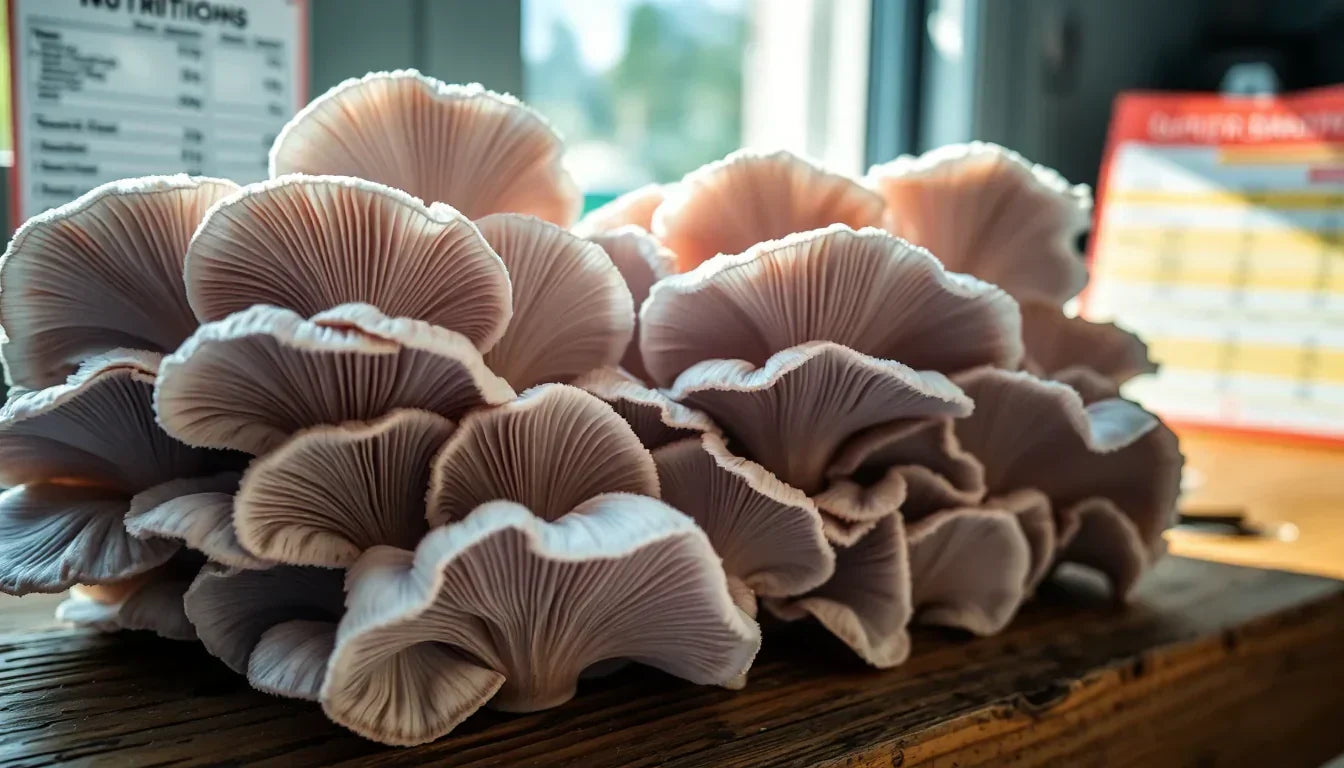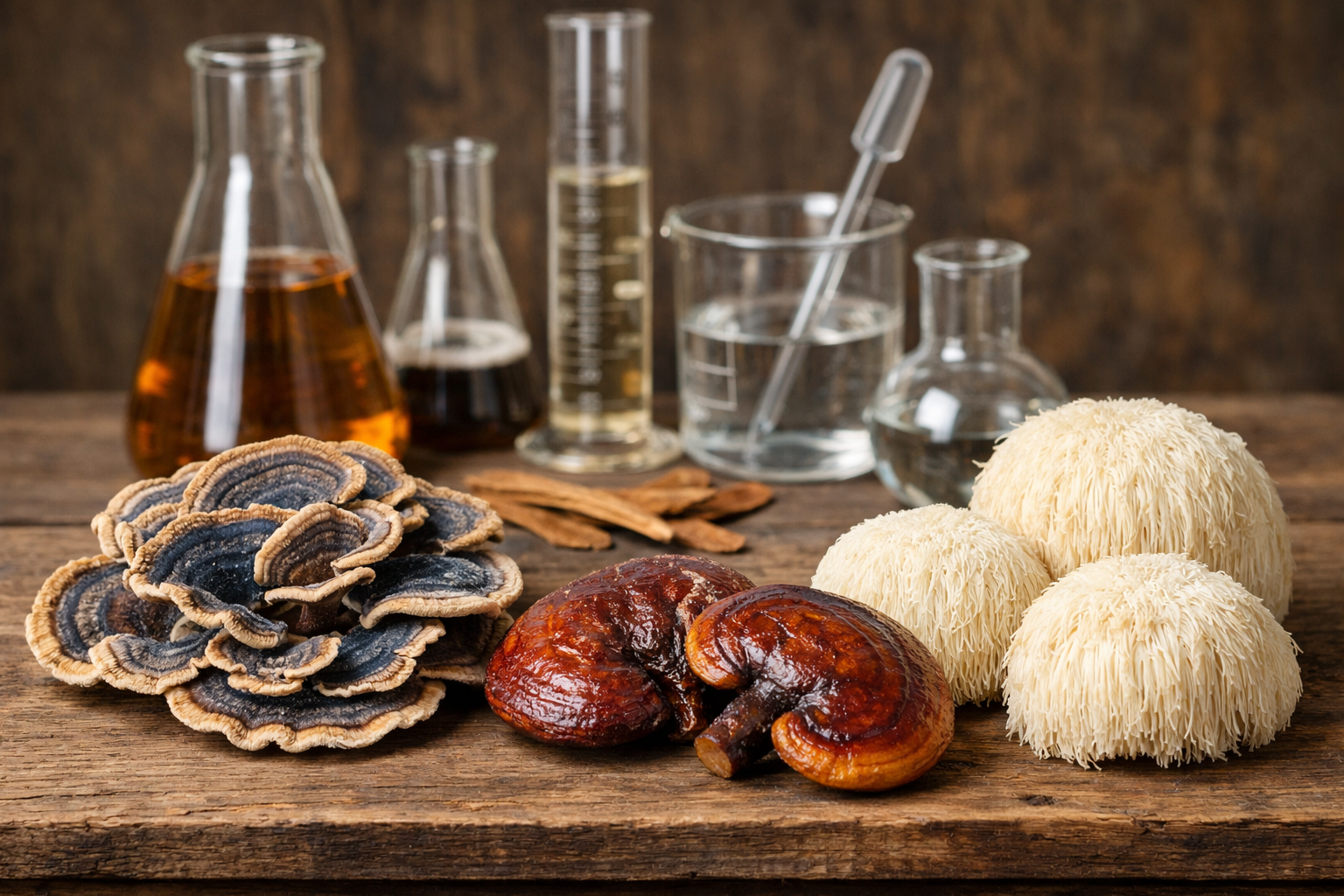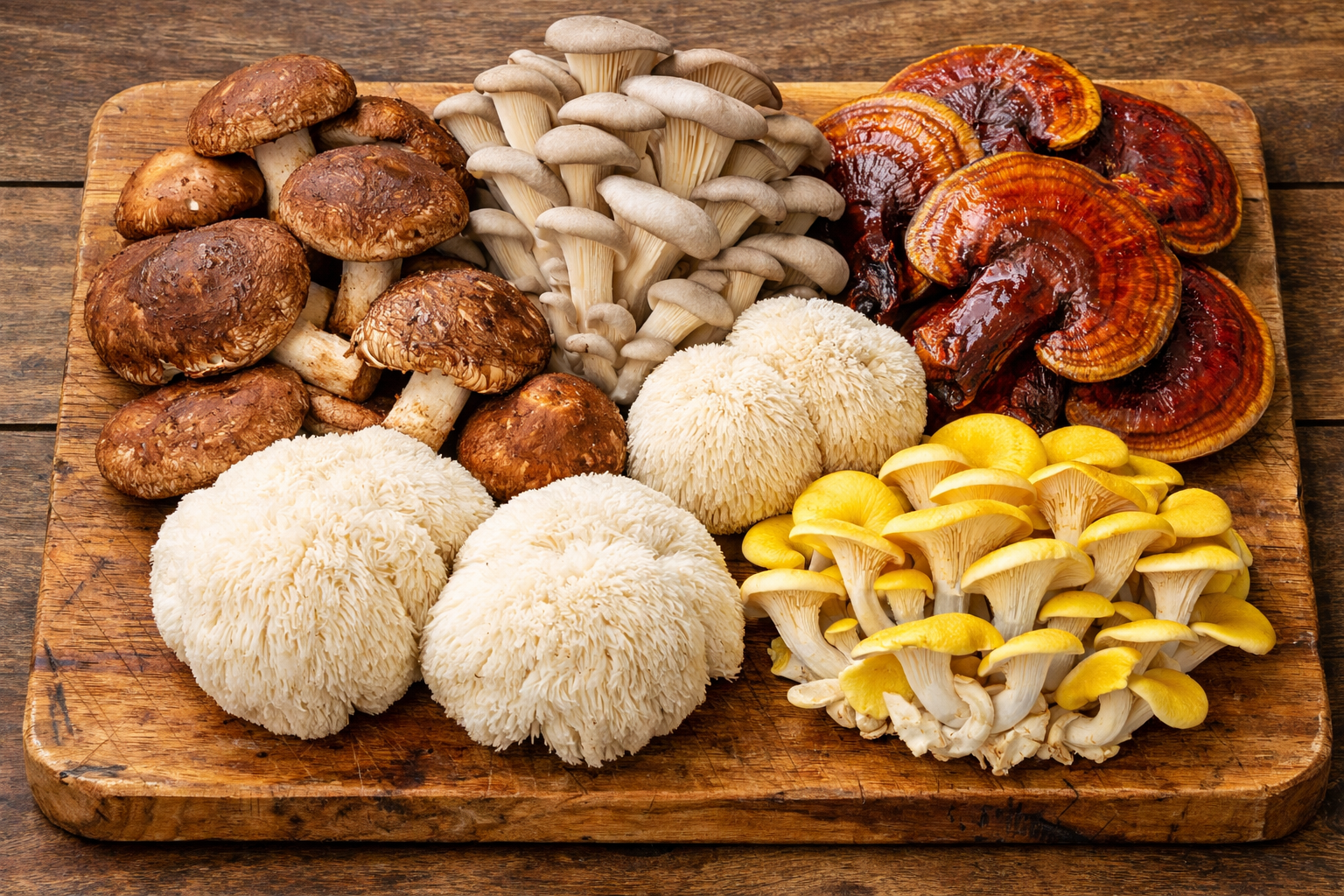Oyster Mushroom Nutrition: A Complete Guide to This Superfood's Health Benefits
Introduction to Oyster Mushrooms
Oyster mushrooms (Pleurotus ostreatus) are among the most versatile and nutritionally impressive fungi available today. Named for their oyster-shaped caps and delicate flavor profile, these mushrooms have gained popularity worldwide not only for their culinary versatility but also for their exceptional nutritional properties. Their fan-like appearance ranges in color from white to gray, blue, or even pink, depending on the variety, and they grow naturally on fallen trees and decomposing wood in temperate forests around the world.
What makes oyster mushrooms particularly noteworthy from a nutritional standpoint is their remarkable combination of protein, fiber, vitamins, minerals, and bioactive compounds, all packed into a low-calorie, low-fat package. As interest in plant-based diets and functional foods continues to grow, oyster mushrooms have emerged as a nutritional powerhouse worthy of attention from health-conscious consumers, nutritionists, and culinary professionals alike.
Whether you're considering adding these mushrooms to your diet for their culinary appeal, nutritional benefits, or both, understanding their complete nutritional profile can help you maximize the advantages of incorporating them into your meals. This comprehensive guide explores the nutritional composition of oyster mushrooms, their health benefits, and practical ways to include them in a balanced diet.

Oyster Mushroom Nutritional Profile
Macronutrient Composition
Oyster mushrooms offer an impressive nutritional profile with a favorable balance of macronutrients:
-
Caloric content:
- Exceptionally low in calories: approximately 30-35 calories per 100g serving
- Makes up less than 2% of daily caloric intake based on a 2,000 calorie diet
- Provides nutritional density without caloric burden
-
Protein content:
- Contains approximately 3-4g of protein per 100g serving
- Offers all nine essential amino acids, though in varying proportions
- Provides approximately 5-7% of daily protein needs per serving
- Higher protein content than most vegetables
-
Carbohydrate profile:
- Contains 6-7g of total carbohydrates per 100g
- Nearly half of the carbohydrate content is dietary fiber (2.3-3.8g)
- Low glycemic impact due to fiber content and minimal simple sugars
- Contains beneficial complex carbohydrates including beta-glucans
-
Fat content:
- Extremely low in fat, with less than 0.5g per 100g serving
- Contains primarily unsaturated fatty acids
- Naturally cholesterol-free
- Contains trace amounts of omega-6 and omega-3 fatty acids
-
Fiber profile:
- Rich source of dietary fiber with 2.3-3.8g per 100g
- Contains both soluble and insoluble fiber types
- Provides 8-15% of daily fiber needs per serving
- Includes prebiotic fibers that support gut health
This balanced macronutrient profile makes oyster mushrooms an excellent addition to various dietary patterns, including weight management, heart-healthy, and plant-based diets.
Vitamin Content
Oyster mushrooms contain an impressive array of vitamins, particularly B vitamins:
-
B vitamin complex:
- Niacin (B3): 4.9-5.8mg per 100g (30-36% of Daily Value)
- Riboflavin (B2): 0.35-0.49mg per 100g (27-38% of Daily Value)
- Pantothenic acid (B5): 1.3-2.2mg per 100g (26-44% of Daily Value)
- Thiamine (B1): 0.1-0.2mg per 100g (8-17% of Daily Value)
- Pyridoxine (B6): 0.11-0.16mg per 100g (6-9% of Daily Value)
- Folate (B9): 38-44mcg per 100g (9-11% of Daily Value)
-
Vitamin D potential:
- When exposed to UV light before or after harvesting, oyster mushrooms can produce vitamin D2
- UV-exposed oyster mushrooms can contain 140-630 IU per 100g (35-157% of Daily Value)
- One of the few non-animal food sources that can provide significant vitamin D
-
Other vitamins:
- Vitamin C: 0-3mg per 100g (0-3% of Daily Value)
- Vitamin E (tocopherols): Small amounts, primarily alpha-tocopherol
- Vitamin K: Trace amounts of vitamin K1 (phylloquinone)
-
Factors affecting vitamin content:
- Growing conditions (substrate, light exposure)
- Mushroom maturity at harvest
- Storage conditions and duration
- Cooking methods and duration
The B vitamin content is particularly notable, as these vitamins play crucial roles in energy metabolism, nervous system function, and cellular health.
Mineral Content
Oyster mushrooms provide a valuable array of essential minerals:
-
Major minerals:
- Potassium: 300-420mg per 100g (6-9% of Daily Value)
- Phosphorus: 100-150mg per 100g (8-12% of Daily Value)
- Magnesium: 18-24mg per 100g (4-6% of Daily Value)
- Calcium: 3-15mg per 100g (less than 2% of Daily Value)
- Sodium: 15-18mg per 100g (less than 1% of Daily Value)
-
Trace minerals:
- Iron: 1.3-2.1mg per 100g (7-12% of Daily Value)
- Zinc: 0.7-1.4mg per 100g (6-13% of Daily Value)
- Copper: 0.2-0.4mg per 100g (22-44% of Daily Value)
- Selenium: 2.6-9.3mcg per 100g (5-17% of Daily Value)
- Manganese: 0.1-0.3mg per 100g (4-13% of Daily Value)
-
Mineral bioavailability considerations:
- Lower phytate content than many plant foods, increasing mineral absorption
- Presence of organic acids that may enhance mineral absorption
- Cooking methods can affect mineral retention and availability
-
Unique mineral properties:
- Natural sodium-to-potassium ratio supports healthy blood pressure
- Balanced profile of minerals supporting bone health
- Contains trace minerals often lacking in typical diets
The mineral content of oyster mushrooms contributes to their value in supporting various bodily functions, from fluid balance to bone health and oxygen transport.
Bioactive Compounds
Beyond traditional nutrients, oyster mushrooms contain numerous bioactive compounds with potential health benefits:
-
Beta-glucans:
- Complex polysaccharides with immune-modulating properties
- Typically contain 5-7% beta-glucans by dry weight
- Primarily 1,3 and 1,6 beta-glucan linkages associated with immune function
- Retain significant activity even after cooking
-
Antioxidant compounds:
- Phenolic compounds, including flavonoids and phenolic acids
- Ergothioneine, a powerful antioxidant rarely found in food sources
- Selenium-containing compounds with antioxidant properties
- Vitamin E compounds (tocopherols)
-
Specialized proteins and peptides:
- Lectins with immune-modulating properties
- Bioactive peptides released during digestion
- Enzymes with antioxidant properties like superoxide dismutase
-
Other beneficial compounds:
- Natural lovastatin and related statins in some varieties
- Dietary chitin and chitosan from cell walls
- Terpenes and terpenoids with various bioactivities
- Small amounts of specialized plant sterols
These bioactive compounds contribute significantly to the functional food status of oyster mushrooms, providing benefits beyond basic nutrition that may support overall health and disease prevention.
Health Benefits of Oyster Mushroom Nutrition
Immune System Support
The nutritional components in oyster mushrooms offer significant benefits for immune function:
-
Beta-glucan mechanisms:
- Activate and modulate macrophages and natural killer cells
- Enhance cytokine production for immune signaling
- Support appropriate immune response to pathogens
- Help regulate overactive immune responses
-
Vitamin D contribution (when UV-exposed):
- Supports innate and adaptive immune responses
- Helps regulate inflammatory processes
- Enhances antimicrobial peptide production
- Plays a role in preventing excessive immune activation
-
Micronutrient support:
- Selenium and zinc are essential for optimal immune cell function
- B vitamins support metabolic processes needed for immune response
- Copper contributes to antioxidant enzymes that protect immune cells
- Iron supports oxygen transport needed for immune cell activity
-
Research findings:
- Laboratory studies show enhanced natural killer cell activity
- Animal studies demonstrate improved pathogen resistance
- Preliminary human studies suggest reduced incidence of upper respiratory infections
- Emerging research on autoimmune modulation potential
Regular consumption of oyster mushrooms as part of a balanced diet may help maintain robust immune function, potentially reducing susceptibility to common infections while supporting appropriate immune regulation.
Heart Health Benefits
The nutritional profile of oyster mushrooms supports cardiovascular health through multiple mechanisms:
-
Cholesterol management:
- Natural statins (lovastatin and related compounds) may help regulate cholesterol production
- Beta-glucans bind to cholesterol in the digestive tract, limiting absorption
- Low saturated fat and zero cholesterol content supports healthy lipid profiles
- Fiber content helps remove excess cholesterol from the body
-
Blood pressure support:
- High potassium-to-sodium ratio helps maintain healthy blood pressure
- Peptides with ACE-inhibitory activity may support blood pressure regulation
- Antioxidants help protect blood vessel integrity and function
- Ergothioneine may help protect against endothelial dysfunction
-
Anti-inflammatory effects:
- Bioactive compounds help modulate inflammatory processes in blood vessels
- Reduction in oxidative stress helps prevent vascular inflammation
- Balanced fatty acid profile supports healthy inflammatory response
- Bioactive peptides may help regulate inflammatory signaling
-
Additional cardiovascular benefits:
- Fiber helps regulate blood glucose, reducing cardiovascular risk
- B vitamins support healthy homocysteine metabolism
- Antioxidants help prevent LDL oxidation
- Mild antiplatelet effects may support healthy blood flow
Research suggests that regular consumption of oyster mushrooms as part of a heart-healthy diet may contribute to improved lipid profiles, better blood pressure management, and reduced cardiovascular risk factors.
Digestive Health Advantages
Oyster mushrooms offer several nutritional components that support digestive wellness:
-
Prebiotic fiber benefits:
- Indigestible fibers serve as food for beneficial gut bacteria
- Beta-glucans promote the growth of Bifidobacteria and other beneficial species
- Fermentation of mushroom fibers produces beneficial short-chain fatty acids
- Supports microbial diversity, a key indicator of gut health
-
Digestive enzyme support:
- Natural enzymes in oyster mushrooms may aid digestion
- Contains compounds that support the body's own digestive enzyme production
- May help improve nutrient absorption and utilization
- Bioactive peptides may support gut barrier function
-
Anti-inflammatory gut effects:
- Polysaccharides may help modulate intestinal inflammation
- Antioxidants protect the gut lining from oxidative damage
- May help reduce symptoms in inflammatory digestive conditions
- Supports healthy gut permeability
-
Weight management support:
- High fiber, low calorie content promotes satiety
- Low glycemic impact helps maintain stable blood sugar
- Prebiotic effects may favorably influence gut bacteria associated with weight management
- Supports healthy digestive transit time
These digestive benefits highlight why oyster mushrooms are increasingly recognized as a functional food that supports gut health, potentially contributing to improved digestion, reduced inflammation, and better overall gastrointestinal function.
Weight Management Support
The nutritional composition of oyster mushrooms makes them particularly valuable for weight management strategies:
-
Caloric efficiency:
- Extremely low calorie density at 30-35 calories per 100g
- High water content (around 90%) contributes to volume without calories
- Provides substantial nutrition with minimal caloric impact
- Can replace higher-calorie ingredients in many recipes
-
Satiety promotion:
- Fiber content slows digestion and promotes fullness
- Protein contributes to satiety and helps preserve lean muscle mass
- Bulk volume fills the stomach, triggering stretch receptors
- Low energy density allows larger portions with fewer calories
-
Metabolic benefits:
- B vitamins support efficient energy metabolism
- Bioactive compounds may improve insulin sensitivity
- Prebiotic effects may support gut bacteria associated with healthy metabolism
- Low glycemic impact helps avoid blood sugar spikes and crashes
-
Practical advantages for weight management:
- Meaty texture makes them satisfying alternatives to animal proteins
- Versatile enough to incorporate into numerous dishes
- Absorb flavors well, reducing the need for calorie-dense sauces
- Can be used to "bulk up" meals, increasing volume without significant calories
These characteristics make oyster mushrooms an excellent addition to weight management diets, providing substantial nutritional value and satisfaction while supporting calorie control goals.

Factors Affecting Oyster Mushroom Nutrition
Growing Conditions and Nutrient Content
The nutritional composition of oyster mushrooms can vary significantly based on cultivation factors:
-
Growth substrate influence:
- Hardwood substrates typically produce higher protein content
- Straw-based substrates may yield higher carbohydrate levels
- Coffee grounds can increase antioxidant compounds
- Supplemented substrates (with bran, etc.) generally increase protein and B vitamins
-
Environmental factors:
- Light exposure increases vitamin D2 content dramatically
- Temperature affects enzyme activity and nutrient development
- Humidity levels influence mushroom moisture content and nutrient concentration
- CO₂ levels can affect growth rate and nutrient allocation
-
Mushroom strain variations:
- Different oyster varieties (pearl, blue, pink, golden, king) have distinct nutrient profiles
- Genetic factors influence secondary metabolite production
- Wild strains often contain higher levels of certain bioactive compounds
- Commercially selected strains may prioritize yield over certain nutrients
-
Harvest timing:
- Younger mushrooms typically have higher protein percentages
- Mature mushrooms often develop more secondary metabolites
- Nutrient content shifts during different growth stages
- Spore development stage affects enzyme and antioxidant levels
Understanding these variables helps explain why nutritional analyses of oyster mushrooms may show ranges rather than exact values, and why mushrooms from different sources may have slightly different nutritional profiles.
Storage and Preparation Effects on Nutrients
How oyster mushrooms are stored and prepared significantly impacts their final nutritional value:
-
Storage impacts:
- B vitamins gradually decrease during refrigerated storage
- Antioxidant compounds may increase slightly in the first 1-2 days after harvest
- Protein content remains relatively stable during proper storage
- Enzyme activity continues post-harvest, affecting nutrient composition
-
Cooking method effects:
- Boiling: Can cause 30-50% loss of water-soluble B vitamins
- Steaming: Preserves approximately 75-90% of most nutrients
- Sautéing: Retains most nutrients and may increase bioavailability of some compounds
- Microwaving: Minimizes nutrient loss due to short cooking time
- Roasting: Concentrates nutrients but may degrade heat-sensitive compounds
-
Processing considerations:
- Drying concentrates nutrients by weight but may degrade some heat-sensitive vitamins
- Powdering increases surface area, affecting both nutrient preservation and bioavailability
- Freezing causes minimal nutrient loss if done properly but can affect texture
- Fermentation can increase bioavailability of certain minerals and bioactive compounds
-
Nutrient-preserving practices:
- Quick cooking methods help retain water-soluble vitamins
- Consuming cooking liquid (soups, stews) preserves leached nutrients
- Pairing with acidic ingredients helps preserve certain vitamins
- Combining with healthy fats improves absorption of fat-soluble compounds
These factors highlight the importance of proper storage and preparation techniques to maximize the nutritional benefits of oyster mushrooms in your diet.
Oyster Mushrooms vs. Other Foods
Nutritional Comparison with Other Mushroom Varieties
Oyster mushrooms have distinct nutritional advantages and differences compared to other common mushroom types:
-
vs. White Button/Cremini/Portobello mushrooms (all Agaricus bisporus):
- Higher protein content (3-4g vs. 2-3g per 100g)
- More substantial niacin (B3) content (30-36% DV vs. 20-25% DV)
- Higher iron levels (7-12% DV vs. 2-5% DV)
- Similar caloric content and fiber profiles
- Lower ergosterol (provitamin D) potential than portobellos
-
vs. Shiitake mushrooms (Lentinula edodes):
- Slightly lower protein (3-4g vs. 2-3g per 100g)
- Higher riboflavin content
- Lower copper content
- Similar beta-glucan levels but different structural types
- Less pronounced umami compounds
-
vs. Maitake mushrooms (Grifola frondosa):
- Similar protein content
- Higher copper and selenium levels in oyster mushrooms
- Maitake typically contains more unique bioactive compounds
- Oyster mushrooms offer more versatile culinary applications
- Both have excellent beta-glucan profiles but with different structures
-
vs. Reishi mushrooms (Ganoderma lucidum):
- Significantly higher culinary utility (reishi is primarily medicinal)
- Lower triterpenoid content
- Higher protein content and better amino acid profile
- More B vitamins
- Reishi contains more distinct immunomodulating compounds
-
vs. Lion's Mane mushrooms (Hericium species):
- Similar macronutrient profiles
- Lion's Mane contains unique nerve growth factors absent in oyster mushrooms
- Oyster mushrooms typically have higher mineral content
- Lion's Mane has more specialized brain health compounds
- Oyster mushrooms are generally more accessible and affordable
Each mushroom variety offers a unique nutritional profile, suggesting that dietary diversity that includes several mushroom types provides complementary benefits.
Comparison with Animal Protein Sources
Oyster mushrooms offer several nutritional advantages when compared to animal proteins:
-
Nutritional similarities and differences vs. meat:
- Lower protein content by weight (3-4g vs. 20-25g per 100g for most meats)
- Zero cholesterol vs. 70-90mg in most meats
- Contains fiber (2.3-3.8g per 100g) while meat has none
- Significantly lower calories (30-35 vs. 200-300 per 100g of meat)
- Contains unique beta-glucans and other bioactive compounds absent in meat
-
vs. Fish and seafood:
- Lower protein content (3-4g vs. 15-25g per 100g)
- Similar mineral diversity but different concentrations
- Contains prebiotic fibers absent in seafood
- Lacks omega-3 fatty acids present in fatty fish
- May have complementary cardiovascular benefits through different mechanisms
-
vs. Eggs:
- Lower protein concentration but with different amino acid profile
- Zero cholesterol vs. approximately 370mg in 100g of eggs
- Contains fiber while eggs have none
- Lower caloric density (30-35 vs. 140-155 calories per 100g)
- Different but complementary vitamin profiles
-
vs. Dairy products:
- Similar protein content to some soft cheeses
- Contains fiber absent in all dairy
- Lower calorie content than most dairy products
- Different mineral profile with advantages in certain trace elements
- Contains unique immunomodulating compounds not found in dairy
-
Practical substitution considerations:
- Works well as partial meat replacement (25-50%) in many recipes
- Provides similar umami flavor profiles to meat
- Offers meaty texture without animal protein concerns
- Can be combined with legumes for complementary amino acid profiles
- May require larger portions to achieve similar satiety to animal proteins
These comparisons highlight the potential of oyster mushrooms as a valuable component in reducing animal protein consumption while maintaining nutritional adequacy, particularly when combined with complementary plant proteins.
Maximizing Oyster Mushroom Nutrition in Your Diet
Best Preparation Methods for Nutrient Retention
Optimize the nutritional value of oyster mushrooms with these preparation approaches:
-
Cleaning techniques:
- Use a dry brush or paper towel to clean instead of washing when possible
- If washing is necessary, use quick rinses rather than soaking
- Pat dry immediately after washing to prevent nutrient leaching
- Clean just before cooking to minimize moisture-related nutrient loss
-
Optimal cooking methods:
- Quick sautéing: Preserves most nutrients while improving digestibility
- Steaming: Excellent for nutrient retention with minimal fat
- Roasting: Concentrates flavors and nutrients with caramelization benefits
- Adding to soups: Allows consumption of any nutrients that leach into cooking liquid
- Limit boiling: If boiled, consume the cooking liquid to retain water-soluble nutrients
-
Nutrient-boosting preparation tricks:
- Expose to sunlight or UV light for 15-30 minutes before cooking to increase vitamin D
- Briefly pre-heat before cooking to activate enzymes that can increase nutrient availability
- Slice or tear along the grain to preserve textural benefits
- Add a small amount of acid (lemon juice, vinegar) during cooking to help preserve certain vitamins
- Pair with a small amount of healthy fat to improve absorption of fat-soluble compounds
-
Storage best practices:
- Store in paper bags rather than plastic to reduce moisture accumulation
- Refrigerate promptly after purchase
- Use within 3-5 days for optimal nutrient content
- If dehydrating, use low temperatures (under 120°F/49°C) to preserve heat-sensitive nutrients
- Consider quick-freezing (blanch first) for longer-term storage with minimal nutrient loss
These preparation methods help ensure you receive the maximum nutritional benefit from your oyster mushrooms while enhancing their culinary appeal.
Creative Ways to Incorporate Oyster Mushrooms
Expand your culinary repertoire with these nutritious oyster mushroom applications:
-
Breakfast applications:
- Sautéed with spinach and garlic as a nutrient-rich toast topping
- Added to egg scrambles or omelets for extra nutrition and texture
- Blended into breakfast sausage alternatives with beans and seasonings
- Incorporated into savory breakfast bowls with whole grains
- Roasted and used as a side for breakfast proteins
-
Main dish innovations:
- Torn into strips as a pulled pork or chicken alternative
- Used as burger patties with complementary plant proteins
- Featured in mushroom "steaks" with herbs and garlic
- Incorporated into stir-fries for quick weeknight nutrition
- Added to pasta sauces for meaty texture and nutrient enhancement
-
Side dish suggestions:
- Simply roasted with olive oil, salt, and herbs
- Tossed in sesame oil and soy sauce as an Asian-inspired side
- Mixed with other vegetables in colorful roasted medleys
- Quick-pickled for probiotic-rich condiments
- Grilled on skewers with complementary vegetables
-
Unexpected culinary uses:
- Dehydrated and ground into nutrient-rich flavor-enhancing powder
- Incorporated into smoothies (pre-cooked and cooled) for nutrition boosts
- Used as a base for mushroom "bacon" with smoke flavoring
- Blended into veggie burger bases for meaty texture
- Incorporated into savory breakfast baked goods
-
Preservation methods that maintain nutrition:
- Marinated in olive oil with herbs for extended refrigerator life
- Quick-pickled for probiotic benefits
- Dehydrated for concentrated nutrition in soups and stews
- Sautéed and frozen in ready-to-use portions
- Fermented with beneficial bacteria for enhanced digestibility
These versatile applications help you enjoy the nutritional benefits of oyster mushrooms in diverse and appetizing ways throughout your weekly meal planning.

Frequently Asked Questions About Oyster Mushroom Nutrition
Common Nutritional Questions Answered
Here are expert answers to frequent questions about oyster mushroom nutrition:
-
Are oyster mushrooms really nutritious, or is it just hype? Oyster mushrooms genuinely deserve their nutritional reputation. They provide an impressive array of vitamins, minerals, and unique bioactive compounds, all with minimal calories. Their B vitamin content, particularly niacin, riboflavin, and pantothenic acid, exceeds many vegetables. When exposed to UV light, they also become one of the few plant-based vitamin D sources.
-
How do oyster mushrooms compare to meat nutritionally? While oyster mushrooms contain less protein by weight than meat (3-4g vs. 20-25g per 100g), they offer several advantages: zero cholesterol, significant fiber content, lower calories, and unique beneficial compounds like beta-glucans that aren't found in animal products. They're best viewed as a partial meat replacement or complement rather than a complete protein substitute.
-
Can I get vitamin D from oyster mushrooms? Yes, but only if they've been exposed to UV light. Wild oyster mushrooms naturally contain vitamin D2, while commercially grown ones typically don't unless intentionally exposed to UV light during or after cultivation. Look for packages specifically labeled as "UV-treated" or "vitamin D-enriched," or expose store-bought mushrooms to direct sunlight for 15-30 minutes before cooking.
-
Are all varieties of oyster mushrooms equally nutritious? Different varieties (pearl, blue, pink, king, golden) have slight nutritional variations. King oyster mushrooms typically contain more protein and fiber, while blue oysters often have higher antioxidant levels. Pink oysters may contain more ergothioneine. However, all varieties provide similar core nutritional benefits, and the differences are relatively minor compared to their overall nutritional similarity.
-
Do oyster mushrooms lose their nutritional value when cooked? Some nutrients are affected by cooking, but many remain stable or become more bioavailable. Water-soluble B vitamins may decrease with boiling, but most minerals remain intact. Beta-glucans are heat-stable and retain their benefits after cooking. Steaming, sautéing, and roasting preserve most nutrients while improving digestibility and flavor.
-
Can oyster mushrooms help with weight loss? With only 30-35 calories per 100g serving, significant fiber content, and moderate protein, oyster mushrooms can be valuable in weight management diets. They provide volume and satiety with minimal caloric impact. Their prebiotic fibers may also positively influence gut bacteria associated with weight management. However, they should be part of a comprehensive approach rather than viewed as a specific weight loss food.
-
Are there any anti-nutrients or concerns with oyster mushroom consumption? Unlike some plant foods, oyster mushrooms contain minimal anti-nutrients. They have low levels of purines (of concern for those with gout) compared to many other protein sources. Some individuals may experience digestive sensitivity due to their chitin content, but cooking improves digestibility for most people. As with any food, allergies are possible but relatively rare with oyster mushrooms.
These evidence-based answers address common questions while providing context for incorporating oyster mushrooms into a nutritious diet.
Conclusion: Making the Most of Oyster Mushroom Nutrition
Oyster mushrooms represent one of nature's most impressive nutritional packages, offering an exceptional combination of vitamins, minerals, and unique bioactive compounds with minimal caloric impact. Their versatility in the kitchen, coupled with their impressive nutrient density, makes them an ideal addition to health-conscious diets of all types.
The nutritional profile of oyster mushrooms supports numerous aspects of health, from immune function and heart health to digestive wellness and weight management. Their unique combination of beta-glucans, ergothioneine, B vitamins, and essential minerals provides benefits that extend beyond basic nutrition into the realm of functional foods with targeted health benefits.
To maximize the nutritional advantages of oyster mushrooms:
- Choose fresh, firm specimens with vibrant color
- Store properly in paper bags in the refrigerator
- Consider UV exposure to enhance vitamin D content
- Use cooking methods that preserve water-soluble nutrients
- Combine with a small amount of healthy fat for optimal nutrient absorption
- Incorporate variety by trying different oyster mushroom types
- Pair with complementary plant proteins for complete nutrition
Whether you're a plant-based diet enthusiast, an omnivore looking to reduce meat consumption, or simply someone interested in optimizing nutritional intake, oyster mushrooms offer a delicious way to enhance your diet with minimal calories and maximum benefits. Their growing availability in mainstream markets makes this nutritional powerhouse more accessible than ever, providing an opportunity to experience their unique health benefits alongside their culinary versatility.
By understanding the nutritional composition of oyster mushrooms and applying evidence-based preparation methods, you can harness the full potential of this remarkable fungi as part of a balanced approach to health and wellness.














Share:
Oyster Mushroom Identification Guide: How to Spot True Oyster Mushrooms and Avoid Look-Alikes
Oyster Mushrooms Recipe: The Ultimate Guide to Cooking with These Versatile Fungi